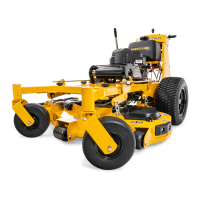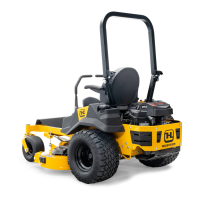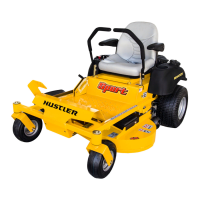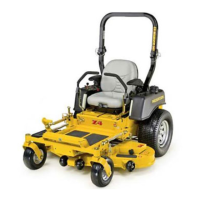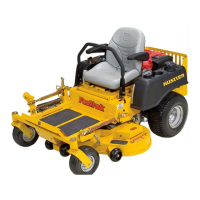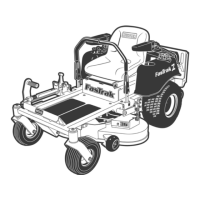REV D 3-6 114510
When turning on soft wet turf, keep both wheels rolling
either forward or backward. Pivoting on one stopped wheel
can damage turf, especially when mowing.
Set the throttle at full rpm for maximum performance. This
gives maximum power to the drive wheels and deck when
needed. The throttle setting directly controls blade speed.
Use the H-Bar
®
handle to control ground speed rather than
engine rpm.
When operating the TrimStar
®
mower on slopes, the
operator should mow traversing the slope. The operator
should stay more on the uphill side of the unit when mowing.
Keep blades sharp. Many problems with incorrect cutting
patterns are due to dull blades or blades which have been
sharpened incorrectly. Information on sharpening blades is
listed in this manual’s maintenance section. Blade sharpness
should be checked daily.
Direct grass discharge to the right, away from the
unmowed area. Generally, this means using a pattern of left
turns. Avoid throwing grass discharge onto unmowed area.
Mowing clippings puts an unnecessary load on the unit and
reduces mowing efficiency.
When mowing a lawn for the first time cut grass slightly
longer than normal to avoid scalping uneven terrain. When
cutting grass taller than six inches, you may want to mow the
lawn twice to achieve a better quality of cut.
During normal mowing cut only about 1/3 of the grass
blade.
Alternate the mowing direction to keep the grass growing
straight and for better dispersion of the clippings.
Remember, grass grows at different rates at different
times of the year. Mow more often in the early spring to
maintain the same cutting height. As the growth rate slows
in midsummer, mow less frequently. If you cannot mow at a
regular interval, mow at a high cutting height; then mow
again two days later at a lower cutting height.
Raise the cutting height of the mower if the cutting width
of the mower is wider than the previous mower. This ensures
that uneven turf is not cut too short.
Raise the cutting height of the mower if the grass is
slightly taller than normal or if it contains a high degree of
moisture. Then mow it again with the cutting height set
lower.
If the machine’s forward motion must be stopped while
mowing, a clump of grass clippings may drop onto your lawn.
To avoid this, move onto a previously cut area with the
blades engaged.
Sharp depressions or raised obstacles (such as
gutters or curbs) should not be directly
approached at high speed in an attempt to “jump”
them as the operator could be thrown from the
equipment. Approach at a slow speed and angle
one drive wheel at the obstruction. Continue at an
angle until the wheel clears and then pivot the
opposite wheel around.
Never work with blades while the engine is running
or deck clutch switch is engaged (on).
Always place the deck clutch switch in the
disengaged position, place the neutral lock/park
brake lever in the park brake position, turn the
engine off and disconnect the negative battery
cable.
Block the mower up when you must work under it.
Wear gloves when handling blades.
Always check for blade damage if the mower
strikes a rock, branch or other foreign object
during mowing!
WARNING
DANGER
Never direct the discharge of material from the
mower deck toward bystanders.
• Never operate the mower deck with the
discharge chute damaged, altered, removed,
or in the raised position, except when the
entire grass catcher attachment or mulching
system is being used. Figure 3-11
Discharge chute may vary from this illustration
A. Discharge chute
Figure 3-11
Never attempt to make any adjustments to the
mower deck while the engine is running or with the
deck drive clutch engaged. Mower blades cannot
be seen and are located very close to the deck
housing. Fingers and toes can be cut off instantly.
WARNING
A
DANGER
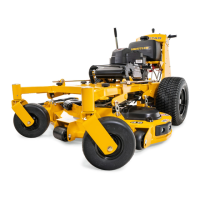
